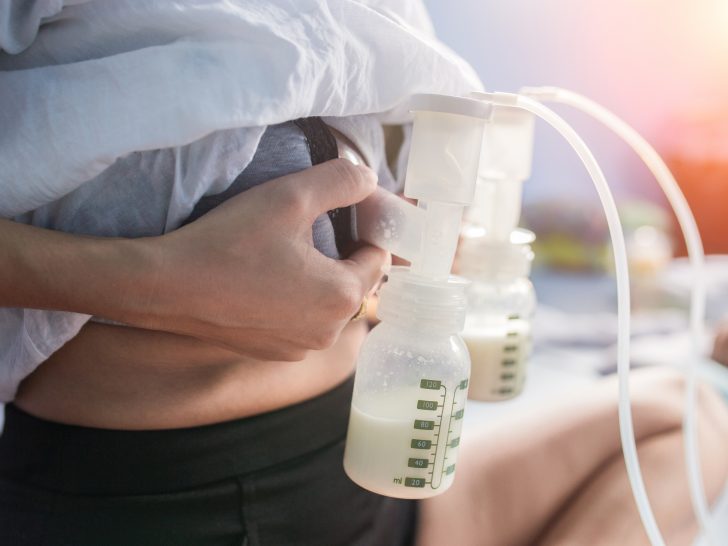Pumping is a great way to make sure your baby has enough milk all the time, but some women encounter unusual obstacles when they start to pump – such as elastic nipples.
Well, it’s only when you start pumping that you really stop to consider their shape. This term has gained in popularity recently, but it’s not exactly a medical term to go by.
Still, the question stands: what are elastic nipples?
How can you tell if you have them?
First off, if you have elastic nipples, there’s no reason to ring the alarms. Most of the time, it’s nothing to get concerned about unless you’re experiencing any pain or discomfort.
In that case, you have to take a few extra steps to ensure your comfort. But don’t worry – we’re here to help!
So, What Are Elastic Nipples?

All nipples have a certain degree of elasticity. So, at what point are nipples considered too elastic? If you’re not experiencing any discomfort, there’s no reason to worry.
However, if you notice that your nipples are stretching way too much to the point where it’s even slightly painful, you have to address the issue – and it’s best to do it right away.
Delaying eventually leads to bruising and makes it even more uncomfortable.
You want to enjoy a smooth, carefree experience when you’re pumping.
If you’ve breastfed your baby in the past, there’s a good chance that you may not have noticed this issue before. And that’s because your baby’s mouth obscures your vision.
You can’t really see what’s going on in there all that well.
But, when you switch to pumping for the first time, that changes things. Now, you not only see your nipples stretched, but the breast pump flange also feels uncomfortable.
Elastic nipples fill the sides all the way to the end of the flange tunnel.
But is it something you need to worry about medically?
Technically, no, but if pumping is causing you discomfort, then you need to work on finding a viable solution. Luckily, there’s a variety of things you can do.
But first, it’s important to know how elastic nipples can cause problems.
What Problems Do Elastic Nipples Cause?

Is it just about pain and discomfort?
No. There’s more to consider. Nevertheless, pain and discomfort are things that mothers face and endure the most with elastic nipples.
Over time, the discomfort can add up. What starts as a slight uneasy sensation eventually causes more pain, making pumping a thousand times more difficult to do.
Pushing through the pain while pumping can bruise your nipples. But before you return to exclusively breastfeeding, take some time to figure out how to deal with the problem.
Even if you’re combing breastfeeding with pumping, knowing this is key.
When the damage is done by repeating the process despite the discomfort, it becomes impossible for your nipple to heal properly because you’re doing it repeatedly.
It makes you less and less able to pump breast milk comfortably.
Over time, this may negatively affect your milk output. How come? Well, the tightness within the flange squeezes too hard, rendering you incapable of emptying your breast.
The longer this goes on, the more severe the issue becomes. So, dealing with it early should be your go-to decision.
How to Deal With Elastic Nipples

Now, the most obvious choice of action is to speak to your lactation consultant for guidance. They will address the issue and work with you to find a suitable solution.
Don’t worry – you’re always in good hands with a professional.
The idea behind talking to your lactation consultant is to determine the cause of the problem. Maybe you do have elastic nipples, but maybe it’s the incorrect flange size.
Whatever it is, seeing a professional will get you quick results.
You can also inspect and adjust the flange size yourself. How can you tell if it’s too big? Well, if the flange is too big, it will pull on the areola and the nipple.
What if the size worked this far, but suddenly something seems off?
Well, it’s not unusual for your flange size to change over the months. Keep track. Some women need to change sizes in order to adapt to the needs of their ever-changing bodies.
If the flange is too small, it may lead to clogged milk ducts.
But a large flange doesn’t cut it either. Find a comfortable size. Too large or too small makes your nipple elasticity problem even worse.
Now, another thing that can help you is lubricating before you start pumping. This has shown great results for many mothers experiencing pain due to elastic nipples.
If you don’t have any oil or lubrication on hand, you can even use your breast milk by hand expressing. It’s a neat trick, but it’s not exactly going to work miracles for you.
Still, it’s worth giving it a shot.
Now, if you’re looking for something efficient – silicone flanges are a great alternative. The way they’re shaped can help alleviate a great deal of pain if you have elastic nipples.
It’s an option that you should definitely explore if you’re having trouble.
The best part about them is that they prevent your areola from being pulled into the flange tunnel. This gives extra room for better pumping and prevents any discomfort.
Experiences vary, so you’re going to have to try it yourself. But, all in all, this might be the very best option if you’re struggling. Combine it with a lubricant for a better effect.
For women with elastic nipples, silicone shields, and cushions work wonders. But if nothing’s working so far, try lowering the vacuum strength.
Many moms make the mistake of thinking that a higher vacuum strength implies a higher milk flow. That’s not always the case. You need to find out what works best for you.
For some mothers, low suction yields the same result as high. So, you may find that lowering the vacuum strength significantly alleviates your discomfort.
Plus, there’s a chance that it won’t impact the flow of your milk.
So, be willing to experiment until you find a solution.
Remember: with pumping; it’s all about comfort.
Let’s summarize your options and include a few extra tips as well:
- Speak to a lactation consultant about how to make pumping pain-free.
- Work on determining the cause behind your discomfort.
- Examine your nipple tissue closely for elasticity.
- Check to see if the flange sizing is right.
- Use lubrication to reduce pain during breast pumping.
- Consider using silicone flanges.
- Try lowering the vacuum strength.
- The size of a flange matters, but so does its length. Try a longer one.
- Go for breast pump cushions.
Elastic Nipples Are Common, and Normal

Do you know what elastic nipples are, exactly? If you do, then you know that moms with elastic nipples are more common than you first might have conceived. And it’s normal.
So you don’t have to worry about your nipple tissue being a little bit too elastic. It’s perfectly fine, and no reason to get worked up about it. There are ways to navigate it.
However, you still have to do your research about it and make sure that you communicate with your lactation consultant in order to find an efficient solution.
Having elastic nipples can decrease your milk supply because they press down on your milk ducts. Luckily, there’s a variety of ways, efficient ways to solve the issue.
From using breast pumps to lubrication – you name it.
And that’s why you shouldn’t be distressed at all if you have elastic nipples. Sure, it might catch you off-guard at first, but a little digging reveals that it’s nothing serious.
Your nipple tissue is just elastic to the point of some discomfort, but using breast pumps or adjusting or changing your flanges will help you keep your baby fed with pumping.
Whether or not you’re breastfeeding – it doesn’t matter.
The key takeaway is that there’s a way to work through this nipple dilemma.
In Conclusion

Every nipple has a certain degree of elasticity – that’s just how it is. But, sometimes, a nipple can be too elastic, making it difficult to use a breast pump without any discomfort.
If you’ve been breastfeeding up until now, and you’re experiencing pain while you pump – don’t worry. When you start to pump for the first time, it takes time to transition fully.
When you have elastic nipples, you have to experiment until you find what works best for you. Sometimes, it’s as straightforward as altering or changing the flange.
If nothing works, reaching out to a lactation consultant will help. After all, that’s your best bet when dealing with elastic nipples. Professional guidance is invaluable.
So, take the time to explore our solutions, but don’t forget to schedule an appointment to find out whether you actually have elastic nipples or if it’s another thing entirely.

Mother of three and a primary school teacher. I’ve always loved being around children and helping them, so I chose my path as a teacher. It is sometimes hectic with three children, but I am 100 percent into it and wouldn’t change it for anything in the world.

